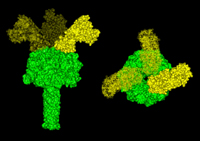From rxpgnews.com
Protective Antigen Ion Channel Asymmetric Blockade To Detect Anthrax Infection
By National Institute of Standards and Technology (NIST)
Aug 29, 2005 - 10:04:00 PM
A new laboratory method for quickly detecting active anthrax proteins within an infected blood sample at extremely low levels has been developed by researchers at the National Institute of Standards and Technology (NIST), the U.S. Army Medical Research Institute of Infectious Diseases and the National Cancer Institute.
Current detection methods rely on injecting live animals or cell cultures with samples for analysis and require up to several days before results are available. Described* in an upcoming issue of the Journal of Biological Chemistry, the new method produces unambiguous results in about an hour. The researchers hope the system will ultimately be useful in developing fast, reliable ways to diagnose anthrax infections or to quickly screen large numbers of drugs as possible therapies for blocking the bacteria's toxic effects.
The method works by detecting changes in current flow when anthrax proteins are present in a solution. An anthrax protein ironically called "protective antigen" spontaneously forms nanometer-scale pores that penetrate the surface of an organic membrane. When a voltage is applied across the membrane, positively and negatively charged ions flow freely in both directions through the pore. When additional anthrax proteins called lethal factor (LF) or edema factor (EF) are present, however, the proteins bind to the outside of the pore and shut down the flow of ions in one direction. This change in current flow depends on the concentration of the proteins in the solution and can detect amounts as low as 10 picomolar (trillionths of a mole).
"We hope this system will lead to a method for rapidly screening agents that inhibit the binding of LF or EF to these pores," says NIST's lead investigator John Kasianowicz.
 |
| A computer model shows side and top views of two different proteins produced by anthrax bacteria. The green molecule is "protective antigen" (PA), which spontaneously forms pores that penetrate organic membranes such as cell walls. The yellow molecule is "lethal factor (LF)." When a voltage is applied across a membrane studded with PA pores, both positive and negative ions flow through. Once LF binds to the pore, however, current only flows in one direction. Image credit: T. Nguyen, National Cancer Institute |
Live anthrax antibodies seem to do exactly that. When antibodies were present in the test solution and then LF was added, the current flow remained unchanged, indicating that the anthrax proteins were unable to bind properly. The long-term goal would be to find drugs with few side effects that also interfere with this binding process.
All rights reserved by www.rxpgnews.com
